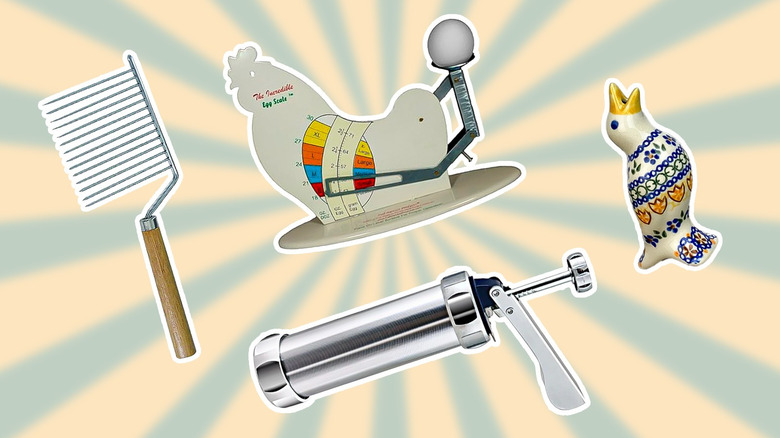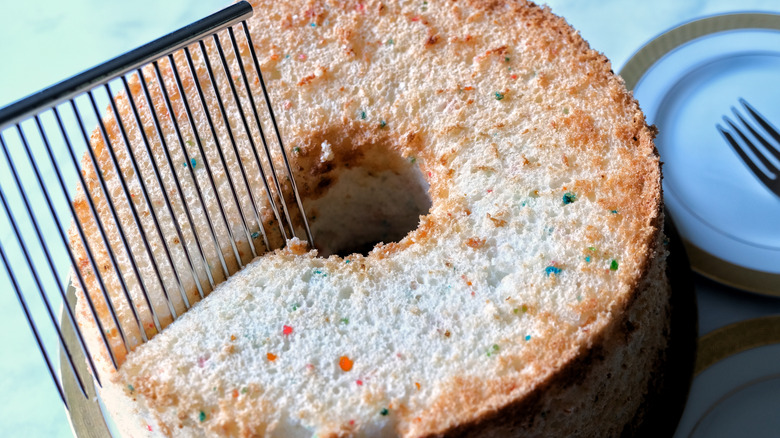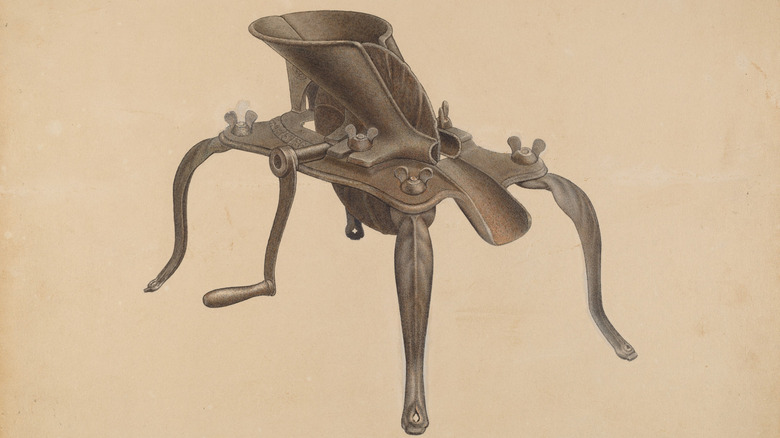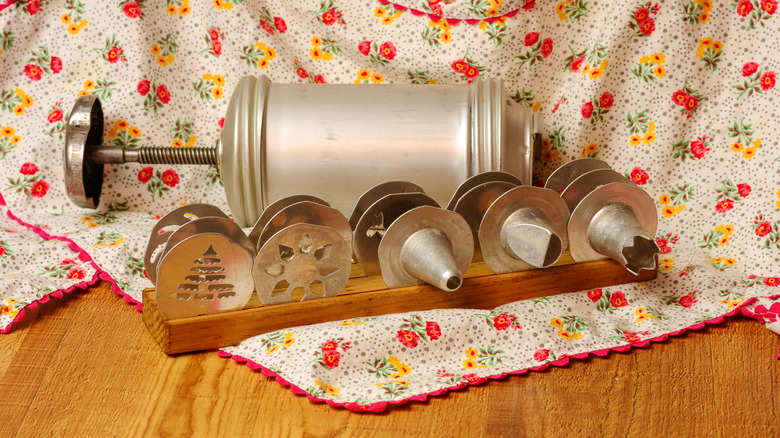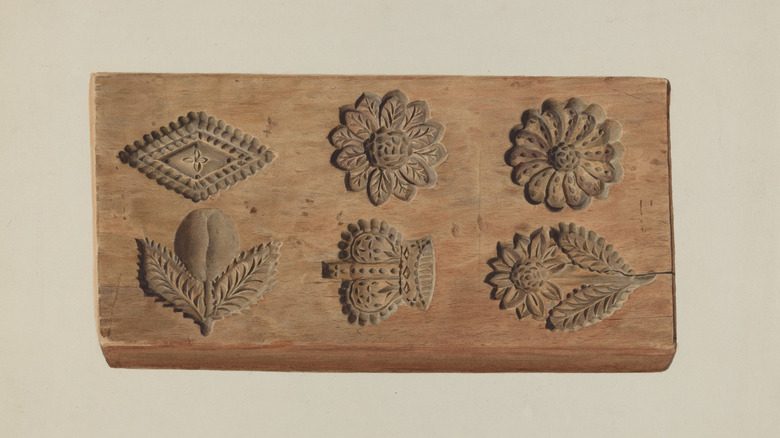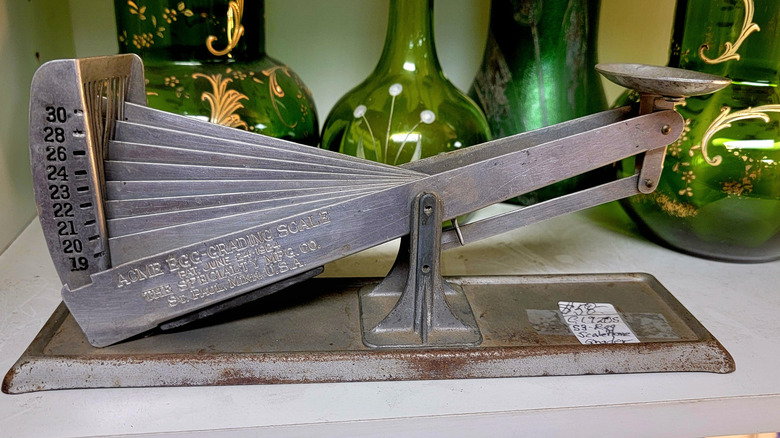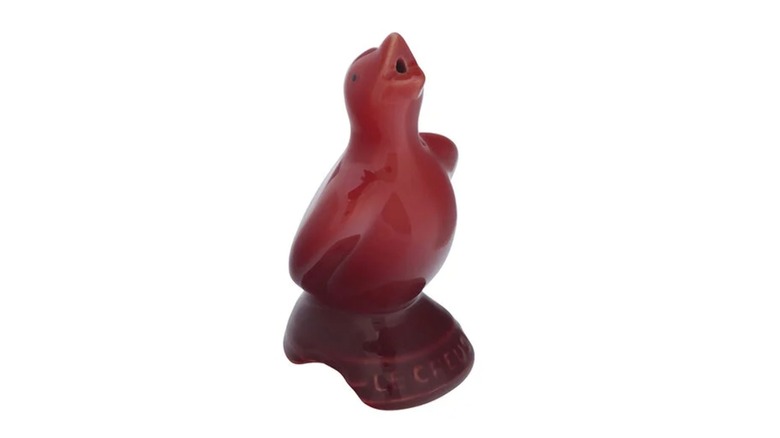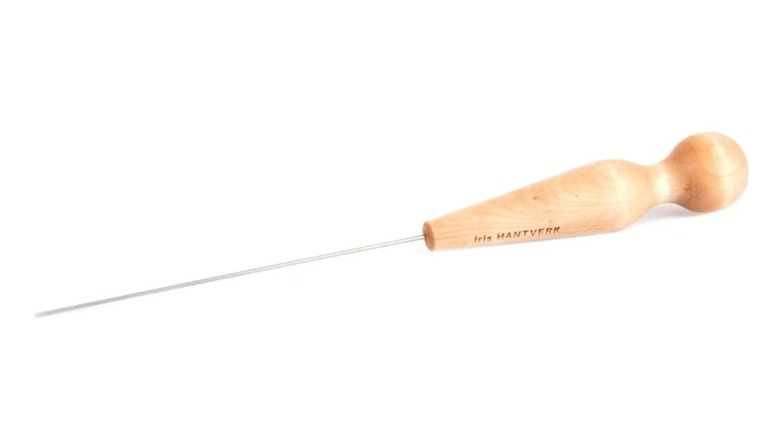9 Vintage Baking Tools People Don't Use Anymore
We may receive a commission on purchases made from links.
Just like everything else, kitchen trends come and go. Today, modern kitchens call for simple gadgets. The smaller and the more functional, the better, especially for the city folks making do in itty bitty kitchens. These days, just about every kitchen tool has to be plugged in, but once upon a time, the only electricity you really needed was for the oven. The first geniuses to discover bread did so without many resources at all; in fact, it was often baked on hot stones or in a pile of ashes.
Vintage baking tools are more often decorative than useful today, but they used to serve a lot more than just aesthetics. They say "if it ain't broke, don't fix it," but companies have been trying to one-up the last trending kitchen gadget since well before the social media days. These vintage baking tools were once a standby in household kitchens, but now, sadly, they're nearly extinct. Many of these baking tools have been nudged aside by electricity, silicone, and digitized equipment, but they're still lingering in the backs of pantries and flea market shelves.
Cake breakers
Once manual rotary beaters entered the market in the 1850s, beating eggs and flour became easier than before. A new era of desserts emerged, one of the most popular being the angel food cake. Cream of tartar and egg whites made it incredibly light and airy. Biting into it is like taking a mouthful of a fluffy cloud, so, as expected, it can be difficult to slice. A knife can ruin a delicate cake with just one slice, but a cake breaker can't. This specialized cake knife could easily be mistaken for a garden tool. It has long, thin pointed prongs that carefully separate delicate cakes without making a crumbly mess or squashing out all the air bubbles.
Given the amount of time it can take to perfect an airy cake batter (and bake it to perfection) it's heartbreaking to ruin the presentation in mere seconds all because of a dull blade. In 1932, Cale Schneider patented the cake breaker to conquer this baking obstacle, and the product was quickly a hit in household kitchens. The cake breaker's decline began in the 1950s and into the '60s as cake mixes became more reliable and home bakers became less invested in reaching professional-level results. By this time, inexpensive serrated knives performed the same job with fewer dishes to wash, so the choice was a no-brainer.
Rotary egg beaters
Long before stand mixers and electric beaters, bakers did all the heavy lifting by hand cranking rotary egg beaters. The gadget, first patented by Willis Johnson in 1884, was a step up from the original metal whisk. The double whisks worked in tandem to whisk not only eggs, but also a variety of tough mixtures and creams into airy batters. The tool was particularly prized for its control. Unlike modern electric mixers, you could easily adjust its speed and stop instantly.
There were a handful of designs that emerged around this time, but it was the Dover egg beater that became the most popular, likely because it could be used for more than just eggs. Once electric hand mixers came into play, it was game over for the wrist-tiring, hand-cranked option. Automated ones first appeared in commercial kitchens in the early 1900s, but it took a few decades to gain popularity and ultimately displace their manual predecessor once patented in 1961.
Cherry pitters
Before the wave of jarred maraschino cherries dominated desserts, fresh cherries were the way to go. But the pits were always a deterrent. How can you make that perfect cherry pie with all those pesky pits? Why, with the antique cherry pitter, of course! There are plenty of de-pitting hacks, like using a piping tip or stabbing a straw through the center of the fruit, but when there are 10 pounds of cherries at stake, you'll need something more industrial.
There are a variety of handheld cherry-pitting devices, but the tabletop version is long gone. Also referred to as a cherry stoner, it was a hunky piece of cast iron that attached to any table or counter like a carpentry workshop clamp. You would drop a fresh cherry into the chamber, then press down the handle, and voilà, a perfectly pitted cherry ready for pie or cobbler.
This tool may not be strictly for baking, but the tabletop cherry pitter can be a huge relief for pie season. It worked wonders, and with the leverage of the table, saved a lot of effort for bakers. While it cranked out cherries at optimal speed, it didn't reveal the most beautiful stone fruit. The cherry would often come out a little worse for wear, which only mattered if cherries were intended to be highlighted front and center, not when being used as a pie filling or jam. As efficient as they were, cherry pitters started to vanish once more accurate devices came out.
Jell-O molds
Jell-O arguably doesn't fall under the baking category, as it doesn't require any actual baking, but as a signature dessert of the disco era, the specialized tool has to be mentioned. Antique Jell-O molds, often made with copper or other alloys, have become kitschy kitchen decor more than an active baking tool. Back in the '40s and '50s, they were used to make gelatin desserts fit for any special occasion. Molded cakes, sculpted puddings, or really any dessert that jiggled would be prepared in one of these gorgeous embossed pans. The resilient shell doubled as a mold for any cake, especially delicate Bundt cakes due to the unmistakable shape. They typically had unique, extravagant shapes with ornate details, resembling intricate castles and domes.
Today, Jell-O is most often a kid's snack or a post-dentist nibble, but back in the '70s, it was peak sophistication. These elaborate copper, aluminum, or tin-plated steel forms shaped countless aspic salads and sweet gelatins that graced dinner tables from the 1920s through the 1970s. Gelatin molding gained popularity following the commercialization of flavored gelatin powders, particularly after Jell-O's introduction in 1897. Jell-O molds fell from favor as entertaining styles became more casual and as health consciousness grew around processed foods. The labor-intensive process of creating elaborate molded dishes seemed increasingly outdated by the 1980s. Many Jell-O fanatics still use the classic molds, but any models still floating around are likely dated well before the 2000s.
Cookie press
The cookie press, or cookie gun, was an incredible baking gadget that surprisingly fell into obscurity. Some brands like Williams Sonoma still produce modern plastic cookie presses, but finding the durable metal ones like Mirro's "cooky-pastry press" will take some internet sleuthing. From the 1930s well into the '60s, bakers were pumping out dozens of cookies with this secret weapon. Most of the early designs came with an assortment of patterned discs that you'd squeeze the dough through, resulting in a perfectly shaped cookie.
Similar to the old Push-Up pops ice cream treat, this cylindrical device used a plunger mechanism to force dough through decorative discs, creating uniform cookies with professional-looking designs in a fraction of the time required for hand-shaping. When rationing made whipping up your favorite recipes a feat during World War II, cookie presses were a godsend. Butter and sugar were not to be wasted, and the cookie press helped bakers use every last drop of dough. As efficient as the tool was, it was hard to compete with store-bought cookies and packaged cakes. By the 1970s, home bakers simply weren't as invested in elaborate cookie decorations, not with pre-made options a hop and a skip away. The only con of cookie presses was the never-ending cleanup. With the introduction of silicone and other non-stick materials, metal baking tools like the cookie press became a chore and were often left behind.
Cookie molds
With a similar purpose as the cookie press, cookie molds were wooden boards, often hand-carved, that would press intricate designs into delicate cookies to create consistent masterpieces. They were often used to adorn butter cookies, as the notoriously delicate and temperature-sensitive dough was tough to work with. The baking tool could even be regarded as an art piece, being beautiful enough to hang on the wall. The wooden carved blocks were also called cookie boards or Springerle molds, and they date back as far as the 14th century. They were especially popular in the mid-1900s, particularly in Pennsylvania Dutch and German households.
These intricate molds featured reverse-carved designs that impressed detailed patterns into rolled cookie dough. The first patterns were often traditional motifs, including religious scenes, flowers, animals, and seasonal celebrations. The most elaborate molds told complete stories across multiple panels, transforming simple cookies into edible art that celebrated holidays and special occasions. These cookie molds became a standard family heirloom, passed down from generation to generation like a family crest.
Egg grading scale
We don't really need to worry about egg grades today, but back in the late 1800s, bakers couldn't be so confident. Nowadays, there are enough egg carton labels for bakers to find exactly what they need, but before farms specified "medium" or "large" on their packages, it was a free-for-all. Before the USDA put these packaging rules into place, home bakers were left to their own devices when grabbing eggs.
For complex cake recipes, the size of the egg can make a huge difference, with most baking recipes calling for large eggs. In the early 1920s, egg grading scales began popping up in home kitchens to help bakers comb through their eggs to find the most perfectly uniform ones. It gave home cooks an advantage that only industrial bakeries were previously acquainted with. The early egg scale models looked like a balancing scale of sorts, with a small pedestal for the egg on one side and weight markers on the other. Oakes Manufacturing Co. seems to be one of the most common manufacturers of the egg grading scale, with a variety of antique models for sale on Etsy and eBay. Eventually, the USDA put into place standardized sizing and labeling protocols, rendering egg grading scales obsolete.
Pie birds
Pie birds might be the most adorable baking accessory, but they also serve an important purpose. Sometimes referred to as a pie funnel or vent, the unseemly functional tool does just that: release air. The small hollow figurine is pressed into the center of a pastry, allowing steam to escape out of the top, or in this case, the bird's beak. The little porcelain gizmo, which originated in Britain, was once the secret to perfect pie crust.
The first pie bird came into play sometime in the mid- to late-1800s, with hopes of keeping hot, bubbling pies intact. The ceramic tool allowed steam to escape from the center, rather than bubbling up beneath the surface and leading to a messy, soggy crust. The simple devices didn't evolve into playful birds and other animals until decades later, but the bird design stuck. Some brands still manufacture the fanciful pie bird, like Le Creuset and Peter Pots Pottery, but for the most part, the product has gone extinct. Pie birds will always serve as an excellent conversation piece, but now modern pie bakers use simple knife slits or decorative cutouts for venting.
Cake testers
When hearing "cake tester," you could easily assume it's in reference to a person responsible for sampling delicious cakes, but it's actually a simple baking tool that doesn't involve any eating at all. Cake testers were the go-to tool for testing doneness before there was the toothpick test.
Cake testers were often made of metal. The slender stick was long enough to puncture layers of cake, giving bakers an inside look at their masterpiece. Aside from any logos or emblems on the top of the pick, the baking tool didn't look like anything special, but it could tell you a lot about your baked goods. In addition to clueing bakers into the consistency of their cake, a cake tester could help them determine the texture based on any resistance felt, and even subtle temperature differences. Master bakers could determine doneness variations across different areas of large cakes. There were also wooden versions that resembled a mini broomstick, with dozens of wispy wooden sticks tied together. If toothpicks aren't your vibe, you can still track down some metal cake testers, like Iris Hantverk's birch-handled one.
